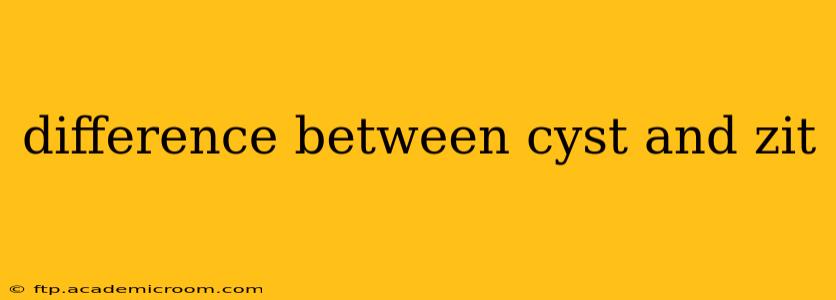Difference Between Cyst and Zit: Understanding Skin Lesions
While both cysts and zits (acne) appear as bumps on the skin, they are fundamentally different in their formation, characteristics, and treatment. Understanding these differences is crucial for proper diagnosis and effective management.
What is a Zit (Acne)?
A zit, more accurately termed a pimple or acne lesion, is a blockage within a hair follicle. This blockage typically involves a build-up of sebum (oil), dead skin cells, and sometimes bacteria. The resulting inflammation leads to the characteristic red, swollen bump often topped with pus. Acne can manifest in various forms, from whiteheads and blackheads to papules, pustules, nodules, and cysts (yes, acne can include cysts).
What is a Cyst?
A cyst is a sac-like structure that's usually filled with fluid, semi-solid material, or air. Unlike acne, cysts are not directly connected to a hair follicle. They can occur anywhere on the body and are often encapsulated, meaning they have a distinct wall separating them from the surrounding tissue. Cysts can be harmless, but some can cause pain, infection, or discomfort. They vary greatly in size and appearance depending on their location and contents.
What are the Key Differences Between Cysts and Zits?
Here's a table summarizing the key distinctions:
| Feature | Zit (Acne) | Cyst |
|---|---|---|
| Cause | Blocked hair follicle, sebum, dead skin cells, bacteria | Various factors, including blocked ducts, inflammation, infection |
| Location | Primarily on face, neck, back, chest | Can occur anywhere on the body |
| Appearance | Red, swollen bump, often with pus-filled head | Varied; can be fluid-filled, firm, or fluctuant; may or may not be inflamed |
| Size | Typically small to medium | Can range from small to very large |
| Pain | Can be painful or mildly uncomfortable | Can be painful, especially if inflamed or infected |
| Treatment | Over-the-counter treatments, prescription medications | Often requires medical intervention; may need drainage or removal |
What is the Difference Between a Cyst and a Nodule?
This is a common question because both cysts and nodules are palpable lumps under the skin. However, a key difference is their structure:
- Cyst: Has a distinct, encapsulated wall surrounding its contents.
- Nodule: A solid mass of tissue, usually inflammatory, and does not have a defined wall. Nodules are often associated with severe acne.
Both nodules and cysts can be painful and require professional medical attention.
How are Cysts and Zits Diagnosed?
Diagnosis is usually made through a physical examination. A doctor can assess the appearance, size, location, and consistency of the lesion to differentiate between a cyst and a zit. In some cases, imaging techniques such as ultrasound might be used to further characterize a cyst.
How are Cysts and Zits Treated?
Zits: Mild acne can often be treated with over-the-counter medications such as benzoyl peroxide or salicylic acid. More severe cases may require prescription medications like retinoids or antibiotics.
Cysts: Treatment for cysts depends on their type, location, and symptoms. Some cysts may resolve on their own, while others may require medical intervention such as drainage, injection, or surgical removal. Infected cysts require antibiotic treatment. Never attempt to drain or treat a cyst at home without medical guidance.
When Should I See a Doctor?
Seek medical attention if you have:
- A large or painful cyst
- A cyst that shows signs of infection (redness, swelling, increased pain)
- Recurrent cysts
- A cyst that doesn't improve with home care
This information is for general knowledge and should not be considered medical advice. Always consult a dermatologist or other qualified healthcare professional for diagnosis and treatment of skin lesions.
